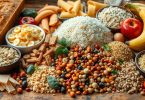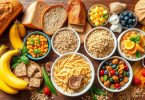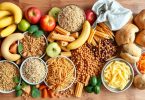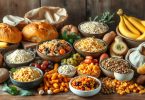#food #Meal #Cuisine #Nourishment #Grub #Sustenance #Fare #Provisions #health #wellness #Victuals #Refreshments #Eats #foods #Nutrition
In the fast-paced world of modern life, feeling drained and fatigued is common. Yet, the secret to endless energy lies in the everyday foods we consume. Enter the world of carbohydrate-rich superfoods, your path to a healthier, more vibrant existence.
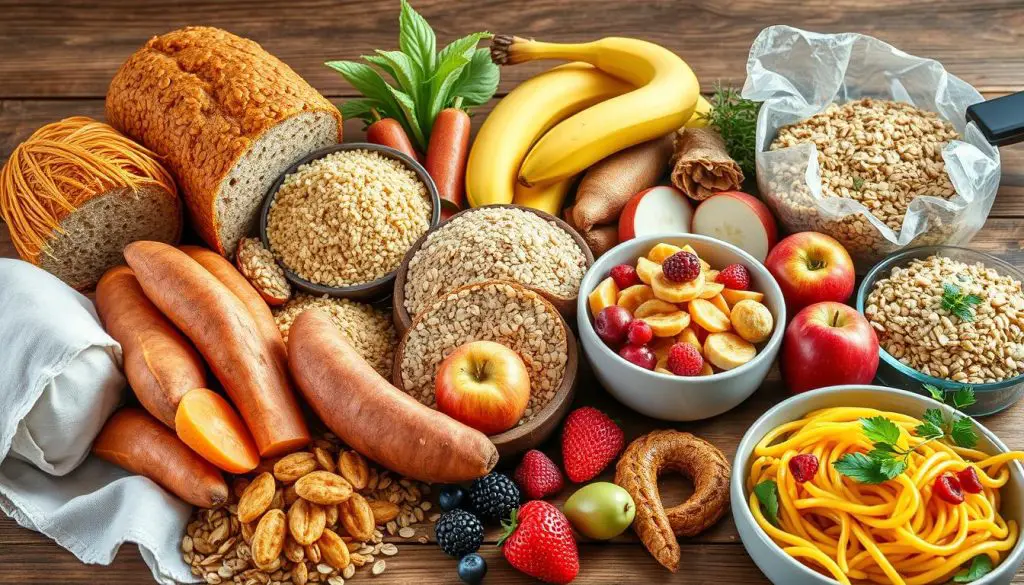
Imagine waking up feeling invigorated, ready to conquer the day without the need for sugary energy drinks or unhealthy snacks. By integrating the correct carbohydrate-rich foods into your regimen, you tap into a natural reservoir of enduring energy. This energy propels you through your daily endeavors and activities.
This detailed guide delves into the top 15 carbohydrate-rich foods that elevate your energy levels and bolster your overall health and well-being. From well-known staples to hidden treasures, these nutrient-dense powerhouses will become your preferred options for energizing your body and mind.
Key Takeaways
- Carbohydrate-rich foods provide the body with essential energy for daily activities.
- Incorporating a variety of energy-boosting foods can help maintain stable blood sugar levels and prevent energy crashes.
- Best carbohydrate foods are nutrient-dense and provide a range of health benefits beyond just energy.
- Choosing healthy carbohydrate sources is crucial for overall well-being and disease prevention.
- A balanced diet rich in carbohydrate-rich foods can support athletic performance and recovery.
Understanding the Power of Carbohydrate-Rich Foods
Carbohydrates serve as the primary energy source for our bodies, powering our cells and daily activities. For athletes aiming to enhance performance or health-conscious individuals seeking well-being, grasping carbohydrate science is essential.
The Science Behind Carbohydrates and Energy
Consuming high-carb foods for energy leads to glucose production, the body’s primary energy source. This glucose is then distributed through the bloodstream, powering organs and tissues. It’s vital for brain function and muscle contractions.
Simple vs Complex Carbohydrates
Carbohydrates differ significantly. Simple carbohydrates, or “simple sugars,” offer quick energy but can cause blood sugar spikes and crashes. In contrast, complex carbohydrates, found in foods with carbs for health, digest slowly, providing sustained energy.
Daily Recommended Intake
The daily carbohydrate intake varies based on age, gender, and activity level. The American Dietary Guidelines recommend 45-65% of daily calories come from carbohydrates. Consulting a healthcare professional or registered dietitian can tailor your intake to your needs.
By comprehending the role of carbohydrate-rich foods, you can make choices that fuel your body and support health and well-being.
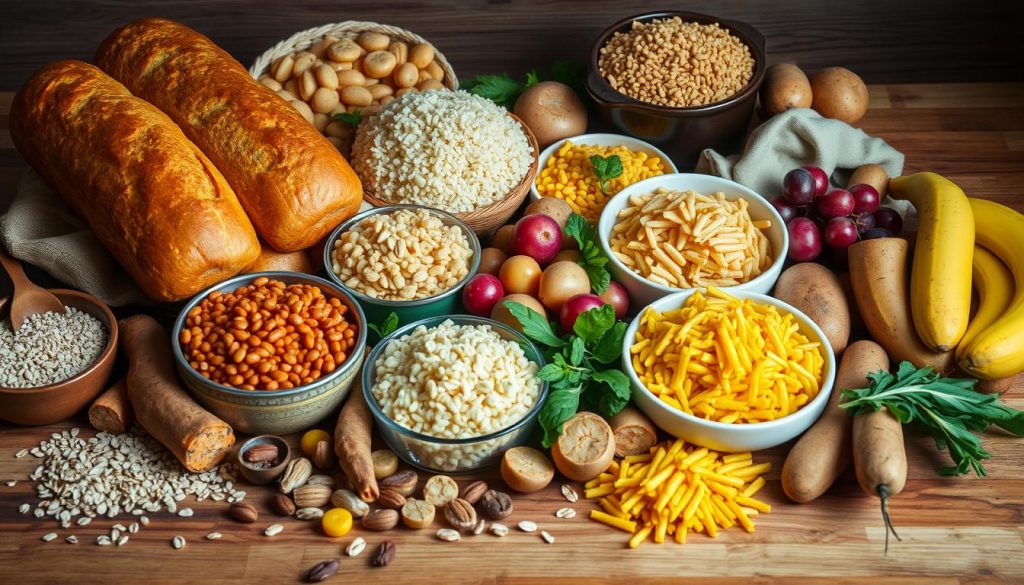
Quinoa: The Complete Protein-Packed Grain
In the domain of high-energy foods, quinoa emerges as a quintessential powerhouse. Originating from the ancient Andean region, this grain is not merely a copious source of carbs for athletes. It also possesses a complete protein profile, rendering it an adaptable option for healthy carbs for weight loss.
Quinoa’s distinct nutritional profile is what sets it apart. Unlike the majority of grains, it encompasses all nine essential amino acids, thereby qualifying as a complete protein. This attribute is pivotal for athletes, as it facilitates muscle recovery and growth, essential for those endeavoring to optimize their workout performance.
Quinoa’s protein content is complemented by its high fiber content, which can induce satiety and contribute to weight management. Its low glycemic index ensures a consistent energy release, making it an exemplary choice for maintaining stable blood sugar levels.
| Nutrient | Quinoa (1 cup cooked) |
|---|---|
| Calories | 222 |
| Carbohydrates | 39 g |
| Protein | 8 g |
| Fiber | 5 g |
| Magnesium | 118 mg |
| Iron | 2.8 mg |
Quinoa’s versatility in culinary applications is unmatched. It can be seamlessly integrated into a myriad of dishes, ranging from salads and soups to pilafs and even desserts. Its light texture and distinct nutty flavor have garnered it widespread acclaim among health-conscious individuals and athletes.
For those aiming to enhance their workout performance, support weight loss endeavors, or simply enrich their diet with more nutrient-dense options, quinoa is an indispensable high-energy food that should be a staple in every pantry.
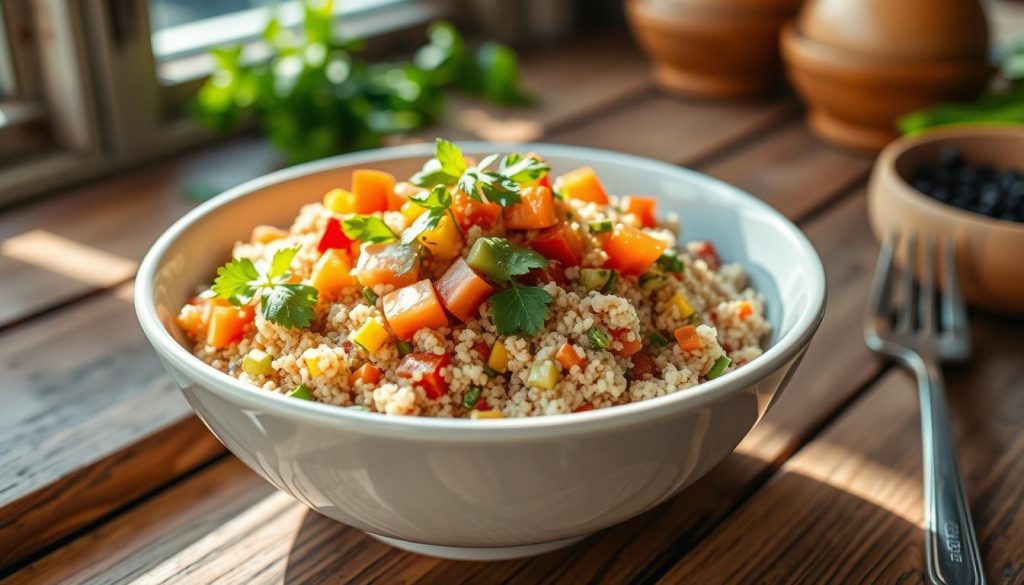
Sweet Potatoes: Nature’s Energy Powerhouse
Sweet potatoes stand out as a premier source of carbohydrates, offering sustained energy and numerous health benefits. This vegetable is a nutritional treasure trove, rich in vitamins, minerals, and complex carbohydrates. It serves as a fuel for both the body and mind.
Nutritional Benefits of Sweet Potatoes
Sweet potatoes are a powerhouse of complex carbohydrates, essential for energy. They are also a significant source of carbs for brain function, thanks to their high levels of beta-carotene, vitamin C, and B vitamins. Furthermore, they are an excellent choice for muscle gain, providing substantial amounts of potassium, magnesium, and manganese.
Best Ways to Prepare Sweet Potatoes
Sweet potatoes are incredibly versatile, lending themselves to a variety of delicious preparations. Roasting sweet potato cubes with olive oil, salt, and pepper creates a simple yet nutritious side dish. They also enhance soups, stews, and salads. Baking them whole and topping with Greek yogurt, nuts, and cinnamon offers a quick, satisfying meal.
Storage and Selection Tips
- Choose sweet potatoes that are firm, free of blemishes, and have a vibrant, even color.
- Store them in a cool, dark place, such as a pantry or cellar, for up to 4 weeks.
- Avoid refrigeration, as it can cause starch to convert to sugar, altering texture and flavor.
Incorporating sweet potatoes into your diet can provide a natural energy boost, support brain health, and aid in muscle recovery. Their versatility and long shelf life make them a standout in the realm of carbohydrate-rich foods.
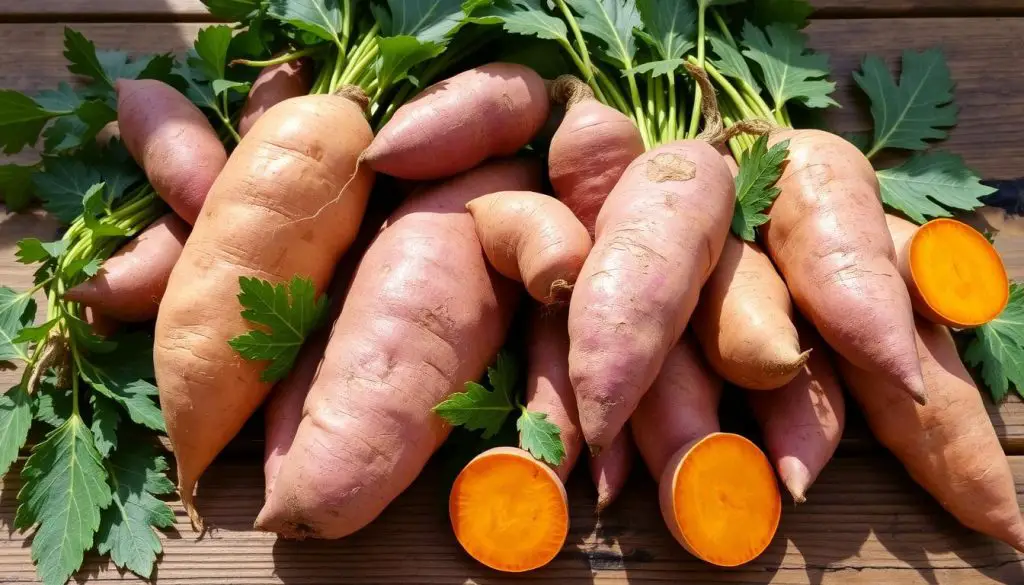
Brown Rice: The Whole Grain Staple
Brown rice emerges as a nutritional giant among energy-boosting carbs. Unlike white rice, it retains the nutrient-dense bran and germ layers. This makes brown rice a superior choice for sustained energy and overall health.
Beyond being a carb-rich snack, brown rice is a high-carbohydrate snack that offers a steady flow of complex carbohydrates. These complex carbs are digested slowly, stabilizing blood sugar levels and ensuring prolonged energy and satiety.
Brown rice is also a treasure trove of essential vitamins and minerals, including magnesium, phosphorus, and B vitamins. These nutrients are vital for metabolism, nerve, and muscle function, playing a key role in bodily functions.
Versatile and Delicious
Integrating brown rice into your diet is straightforward. It can serve as a side dish, enhance soups and stir-fries, or act as a base for bowls and salads. For a quick, nutritious snack, combine brown rice with roasted vegetables or lean protein.
When choosing brown rice, ensure it’s labeled as “whole grain” or “100% whole grain.” Store it in an airtight container in a cool, dry place to maintain freshness. With its versatility and impressive nutritional profile, brown rice is an indispensable energy-boosting carb in any healthy diet.
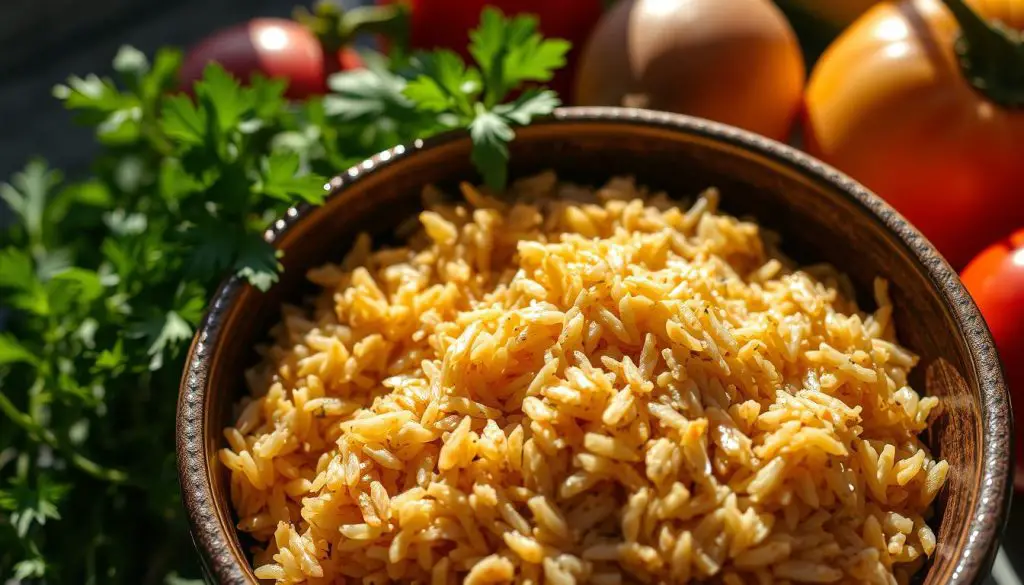
| Nutrient | Amount per 1 cup (195g) of cooked brown rice |
|---|---|
| Calories | 216 |
| Carbohydrates | 44g |
| Fiber | 3.5g |
| Protein | 5g |
| Magnesium | 84mg |
| Phosphorus | 172mg |
| Thiamin (B1) | 0.2mg |
| Niacin (B3) | 1.5mg |
Oats: The Breakfast Champion
Oats emerge as a paragon of nutrient-dense carbohydrates, offering a plethora of benefits. They are an exemplary choice for initiating your day with a nourishing and fulfilling meal. Their versatility makes them a cornerstone in the realm of breakfast options.
Types of Oats and Their Benefits
Oats manifest in various forms, each boasting distinct advantages. Steel-cut oats retain a higher concentration of fiber and nutrients due to minimal processing. In contrast, rolled oats are steamed and flattened, resulting in a creamier texture and a more expedient cooking time. Regardless of the type, oats serve as an exemplary source of carbohydrate foods for weight loss, providing sustained energy throughout the day.
Creative Oatmeal Combinations
Oatmeal, a quintessential breakfast staple, can be reinvented into a delightful and versatile dish. By integrating nutrient-dense toppings such as fresh berries, nuts, and a drizzle of honey, one can craft a meal that is both nourishing and delectable. This approach ensures a balanced intake of carbohydrates while enhancing the overall nutritional profile of the dish.
“Oats are a nutritional powerhouse, providing a steady stream of energy and essential nutrients to kickstart your day.”
Whether you opt for steel-cut or rolled oats, incorporating this versatile grain into your daily regimen can revolutionize your pursuit of a healthy and balanced lifestyle.
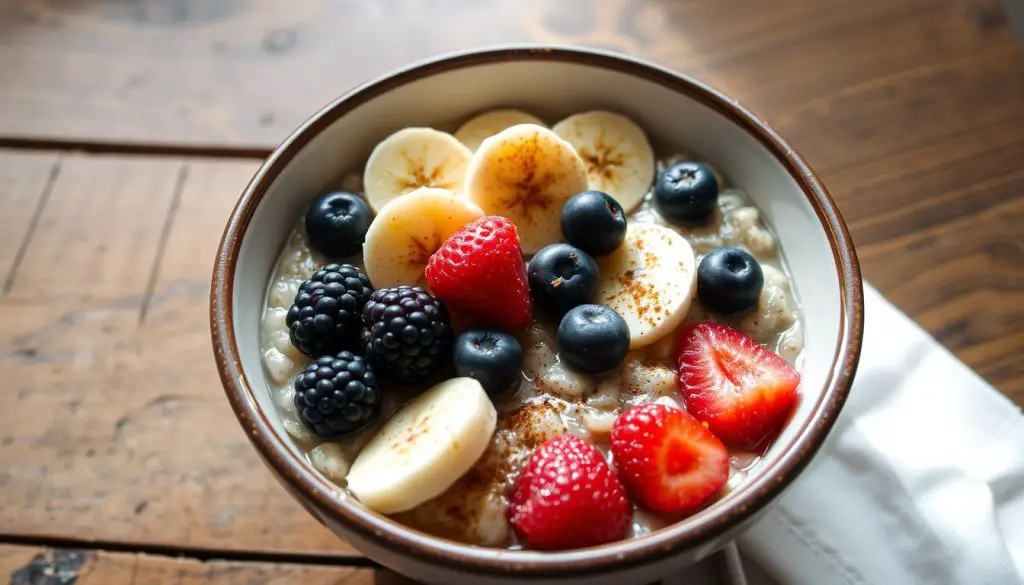
Bananas: Quick Energy Boost
Bananas, a quintessential vegan carbohydrate source, provide a rapid and convenient energy surge. These yellow powerhouses are replete with complex carbohydrates, positioning them as a gluten-free carbohydrate-rich food that energizes both body and mind. For athletes seeking to enhance performance or individuals desiring a healthy carb option, bananas are indispensable in one’s diet.
Rich in potassium, a mineral pivotal for muscle function and nerve transmission, bananas also contain vitamin B6. This vitamin facilitates the conversion of carbohydrates into energy. This synergy of nutrients positions bananas as an exemplary choice for a pre-workout snack or post-workout recovery aid.
| Nutrient | Amount per Medium Banana |
|---|---|
| Carbohydrates | 27g |
| Fiber | 3g |
| Potassium | 422mg |
| Vitamin B6 | 0.4mg |
The convenience and portability of bananas render them a preferred choice for athletes and active individuals. Whether fueling up before a workout or requiring a quick energy boost during the day, bananas serve as a healthy carbohydrate-rich option. They contribute to feeling energized and focused.
“Bananas are the perfect portable snack for busy days or active lifestyles. Their natural sweetness and nutrient-dense profile make them a go-to choice for a quick energy boost.”
Integrating bananas into your diet is a straightforward method to boost your intake of vegan carbohydrate sources, gluten-free carbohydrate-rich foods, and healthy carb options. From pre-workout fuel to on-the-go snacks, bananas are a versatile and nutritious choice for supporting your overall health and wellness.
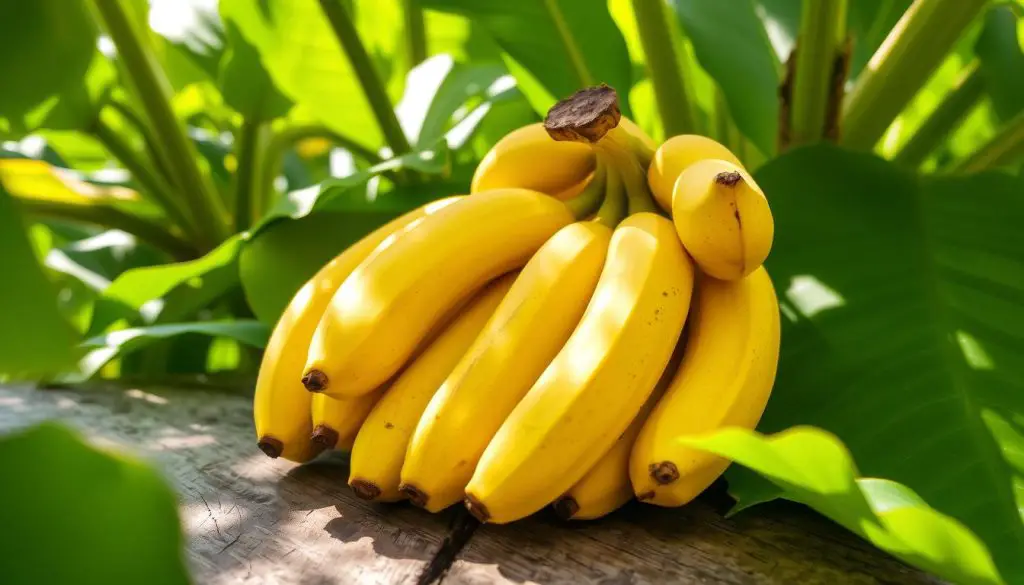
Whole Grain Pasta: Athletic Fuel
Optimizing your athletic performance necessitates the strategic intake of carbohydrates. Whole grain pasta emerges as a prime candidate, offering a rich tapestry of nutrients. It serves as a cornerstone for sustained energy, pivotal for athletes and the vigorously active. This staple is instrumental in fueling workouts and competitions with unwavering vigor.
Choosing the Right Pasta
The diversity in pasta types is vast, yet not all are equally beneficial. Prioritize whole grain varieties, specifically those crafted from 100% whole wheat, brown rice, or other grains of high nutritional value. These energy-boosting foods are replete with complex carbohydrates, fiber, and vital vitamins and minerals. They are designed to nourish the body comprehensively.
- Whole wheat pasta: Offers a more substantial texture and higher fiber content compared to refined pasta.
- Quinoa pasta: A complete protein source that also provides complex carbs for sustained energy.
- Chickpea pasta: A high-protein, gluten-free option that delivers a boost of foods for sustained energy.
Portion Control Guidelines
While pasta can be an excellent energy-boosting snack, moderation is key for maintaining weight and performance. A standard serving of cooked pasta ranges from 1-2 cups, contingent upon individual caloric requirements and activity levels. To create a balanced, energy-fueling meal, complement your pasta with lean proteins, vegetables, and healthy fats.
| Pasta Portion | Calories | Carbohydrates |
|---|---|---|
| 1 cup cooked | 200 calories | 42 grams |
| 2 cups cooked | 400 calories | 84 grams |
By selecting the appropriate whole grain pasta and adhering to portion control, you can adequately fuel your athletic endeavors. This ensures your body receives the steady energy necessary for peak performance.
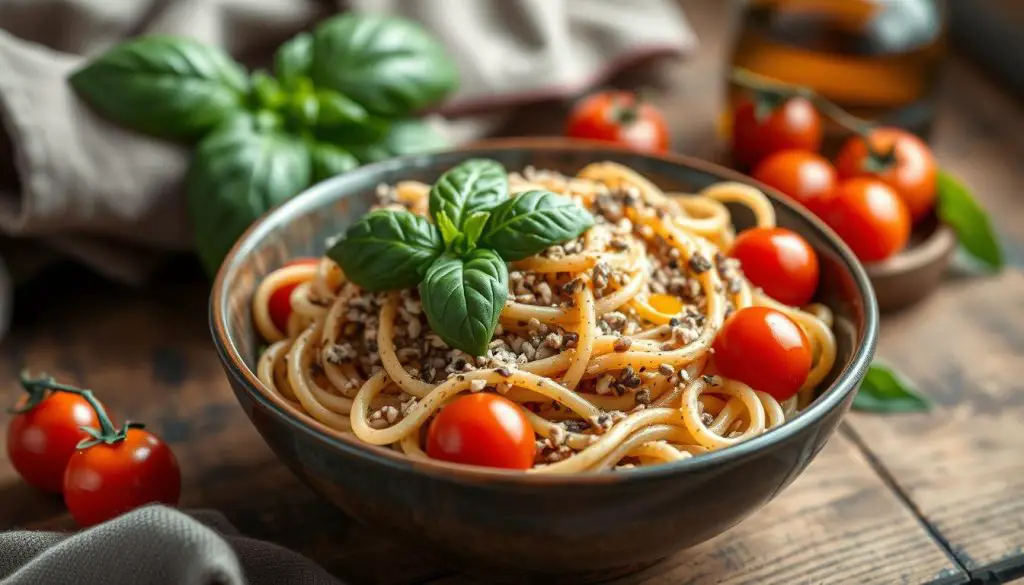
Legumes: Protein-Rich Carbohydrates
Legumes stand out as a unique food group, blending complex carbohydrates with plant-based protein. This combination, found in beans, lentils, peas, and peanuts, forms a nutritious base for a balanced diet. They are ideal for those aiming to manage weight, stabilize blood sugar, or explore vegan options rich in carbs.
The high fiber content in legumes is a significant advantage. Their complex carbs digest slowly, fostering a prolonged sense of fullness. This is particularly beneficial for weight management, as it helps control hunger and reduce cravings.
Moreover, legumes are a prime source of plant-based protein, appealing to vegetarians, vegans, and anyone looking to boost their protein intake. The protein in legumes is complex, providing sustained energy and aiding in muscle development and recovery.
Legumes are also rich in essential vitamins and minerals, including folate, iron, potassium, and antioxidants. These nutrients contribute to overall health, supporting heart health, bone strength, and blood sugar regulation.
Legumes can be enjoyed in various ways, from soups and stews to salads and as standalone dishes. Exploring different types, such as black beans, lentils, or chickpeas, can help you discover your preferred methods of incorporating these complex carbs for weight loss, carbs for blood sugar regulation, and high-carb vegan foods into your diet.
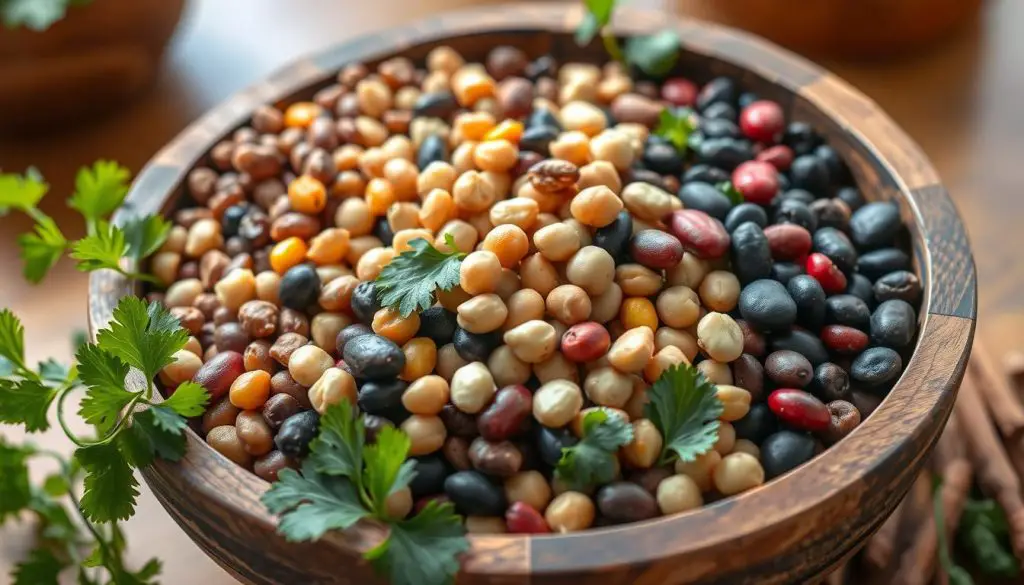
Ancient Grains: Beyond Traditional Choices
In the realm of whole grain carbs, a plethora of ancient grains beckons exploration beyond the conventional. Quinoa and brown rice, renowned for their nutritional density, are joined by amaranth, teff, and sorghum. These lesser-known grains offer a distinct energy boost, enriching our culinary repertoire.
Popular Ancient Grain Varieties
- Amaranth – This gluten-free grain is a treasure trove of complete protein, fiber, and essential minerals such as iron and calcium. Its unique flavor profile, ranging from nutty to earthy, complements both savory and sweet dishes.
- Teff – Despite its diminutive size, teff is a powerhouse of nutrients. It is replete with whole grain carbs, foods rich in fiber and carbs, and is a significant source of iron, calcium, and B vitamins.
- Sorghum – This versatile grain is a treasure trove of whole grain carbs and foods rich in fiber and carbs. Its chewy texture and mild, slightly sweet flavor make it an excellent addition to a variety of dishes.
Cooking Tips and Tricks
Integrating these ancient grains into your diet is surprisingly straightforward. Amaranth can be simmered like quinoa and incorporated into salads, soups, or baked goods. Teff flour is ideal for crafting injera, a traditional Ethiopian flatbread. Sorghum can be popped like popcorn or simmered to serve as a base for pilafs and casseroles.
| Ancient Grain | Nutritional Benefits | Culinary Uses |
|---|---|---|
| Amaranth | Complete protein, fiber, iron, calcium | Salads, soups, baked goods |
| Teff | Whole grains, fiber, iron, calcium, B vitamins | Injera (Ethiopian flatbread) |
| Sorghum | Whole grains, fiber, protein | Pilafs, casseroles, popped like popcorn |
Embark on a journey through the realm of ancient grains to discover novel ways to enhance your meals with whole grain carbs, foods rich in fiber and carbs, and top energy-boosting foods. This exploration promises a nutritional enhancement and a flavorful culinary adventure.
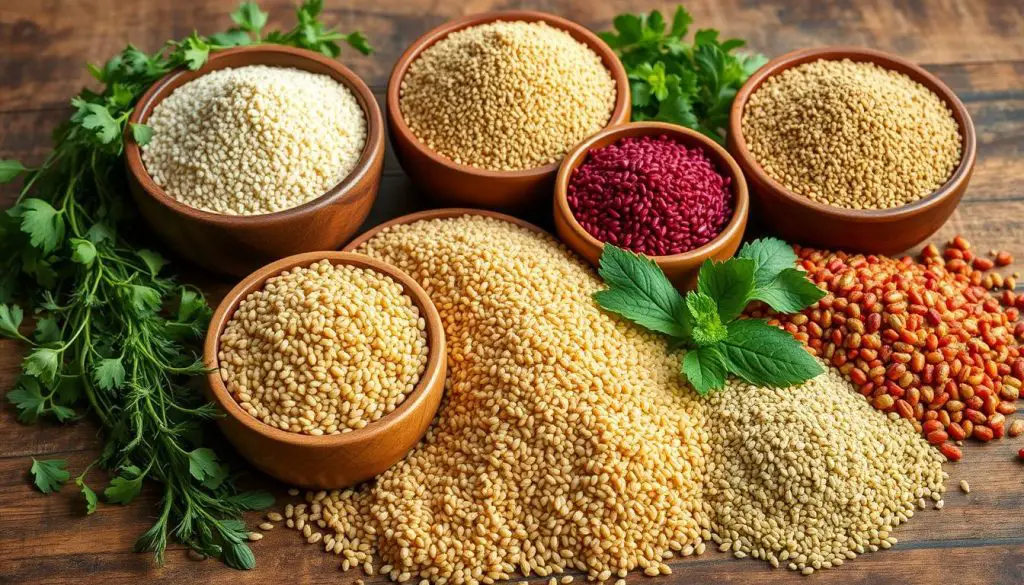
Apples: Natural Sugar and Fiber
Apples, a staple in many diets, are often underappreciated for their nutritional value. These fruits are a remarkable source of carbohydrates for endurance athletes, offering immediate energy during workouts and aiding in muscle repair post-exercise.
Rich in natural sugars and fiber, apples provide a balanced mix of carbohydrates. This mix is crucial for fueling the body before, during, and after physical activity. The soluble fiber, pectin, in apples, aids in slowing down sugar absorption. This results in a more sustained energy release, preventing the typical energy highs and lows.
Apples are not just a carbohydrate powerhouse; they are also a treasure trove of vitamins, minerals, and antioxidants. The skin of an apple contains quercetin, a compound with anti-inflammatory properties. It may help alleviate muscle soreness post-exercise.
| Nutrient | Amount per Medium Apple |
|---|---|
| Carbohydrates | 25 grams |
| Fiber | 4 grams |
| Vitamin C | 14% of the daily value |
| Potassium | 6% of the daily value |
Apples are an excellent choice for a pre-workout snack, a midday energy boost, or a post-exercise recovery aid. They are a versatile and nutritious addition to an active lifestyle.
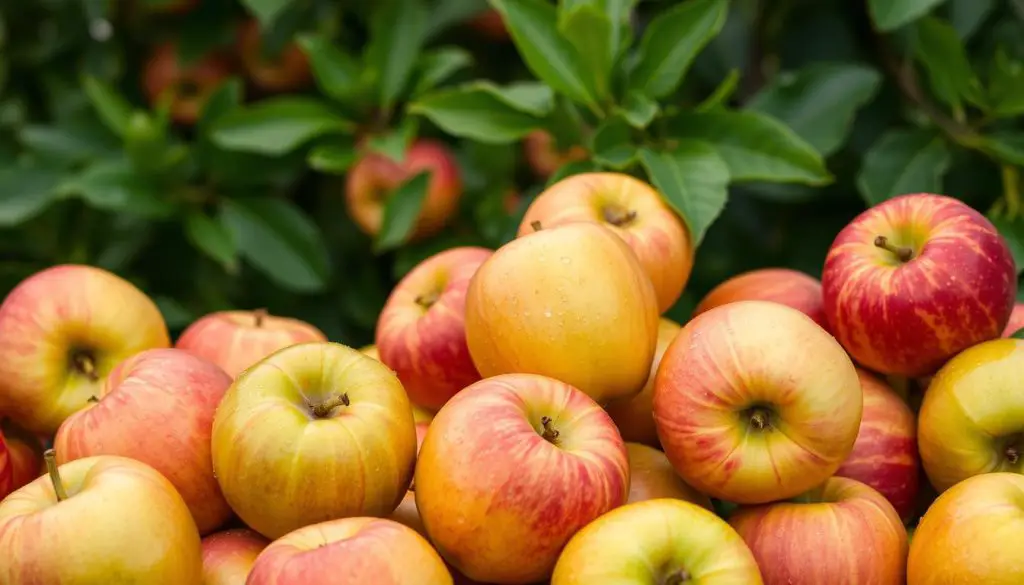
Chickpeas: Versatile Energy Source
Chickpeas, also known as garbanzo beans, are a powerhouse of nutrition, providing sustained energy for fitness goals. These protein-rich legumes are considered among the best carbs for fitness. They offer a unique blend of complex carbohydrates, fiber, and essential vitamins and minerals.
Benefits of Including Chickpeas
Incorporating chickpeas into your diet offers numerous benefits for those seeking long-lasting energy and overall health. These versatile legumes are packed with slow-releasing carbs, maintaining stable blood sugar levels and preventing energy crashes. Additionally, chickpeas are a great source of fiber, promoting feelings of fullness and supporting digestive health.
- High in complex carbohydrates for sustained energy
- Rich in fiber to support digestive and heart health
- Excellent source of plant-based protein to fuel your muscles
- Contains essential vitamins and minerals like iron, folate, and magnesium
Creative Serving Suggestions
The possibilities for incorporating chickpeas into your meals and snacks are endless. From classic hummus to roasted chickpea snacks, these versatile legumes can be enjoyed in a variety of ways to fuel your active lifestyle.
| Serving Idea | Nutrition Benefits |
|---|---|
| Chickpea curry or stew | Provides complex carbs, fiber, and protein for a well-rounded meal |
| Chickpea salad sandwiches | Combines slow-releasing carbs with protein for a satisfying lunch |
| Roasted chickpea snacks | Offers a crunchy, protein-packed alternative to traditional snacks |
By incorporating chickpeas into your diet, you can enjoy the best carbs for fitness and fuel your active lifestyle with long-lasting energy and slow-releasing carbs. Explore the versatility of this nutritious legume and discover new ways to make it a regular part of your healthy, energizing meals.

Butternut Squash: Seasonal Energy Boost
As autumn approaches, butternut squash emerges as a standout seasonal vegetable. Its versatility and nutritional value make it a delightful addition to healthy meals, providing a natural energy boost to fuel your day.
Butternut squash is a rich source of complex carbohydrates, offering sustained energy to keep you energized and focused. It is also a treasure trove of vitamins and minerals, boasting high levels of vitamin A. This vitamin is crucial for immune function and vision health.
The preparation options for butternut squash are vast. It can be roasted, pureed, or incorporated into various healthy carb choices like soups, stews, salads, and pasta dishes. To enhance its nutritional value, consider steaming or roasting it to preserve its carbohydrate nutrition and natural sweetness.
| Nutrient | Amount per 1 cup (205g) |
|---|---|
| Calories | 82 |
| Carbohydrates | 21g |
| Fiber | 6.6g |
| Vitamin A | 457% of the Daily Value |
| Vitamin C | 52% of the Daily Value |
Including butternut squash in your healthy carb-rich meals is a smart choice for supporting your health and energy levels. Its natural sweetness and nutrient-dense profile make it a versatile and satisfying component of any balanced diet.

Whole Grain Bread: Daily Energy Essential
Whole grain bread stands as a cornerstone for daily energy, offering a harmonious blend of carbohydrates that foster optimal health and sustained vitality. Unlike its refined counterparts, whole grain bread retains the germ and bran, which are rich in nutrients. This makes it a formidable source of balanced carbs for energy and carbs for optimal health. The complex carbohydrates it contains are digested at a slower pace, ensuring steady blood sugar levels and averting the energy dips linked to foods with high glycemic index.
In pursuit of whole grain bread, prioritize products that list “whole wheat” or “whole grain” as their primary ingredient. Steer clear of breads formulated with refined flours, as they are devoid of the fiber and vital nutrients present in whole grains. Combining whole grain bread with lean proteins, healthy fats, and fresh vegetables will yield a meal that is both balanced and nourishing. Such a meal will sustain you throughout the day, providing a steady flow of energy.
| Whole Grain Bread Varieties | Nutritional Benefits |
|---|---|
| Whole Wheat Bread | High in fiber, B vitamins, and minerals like iron and magnesium |
| Sprouted Grain Bread | Increased bioavailability of nutrients, reduced anti-nutrients |
| Rye Bread | Rich in fiber, B vitamins, and antioxidants |
| Oat Bread | Provides soluble fiber, beta-glucans, and heart-healthy benefits |
Integrating whole grain bread into your daily regimen is a straightforward method to bolster your health and energy levels. It can be savored at any time of day, from breakfast to a midday snack, making it a versatile and nutritious component of a balanced diet.
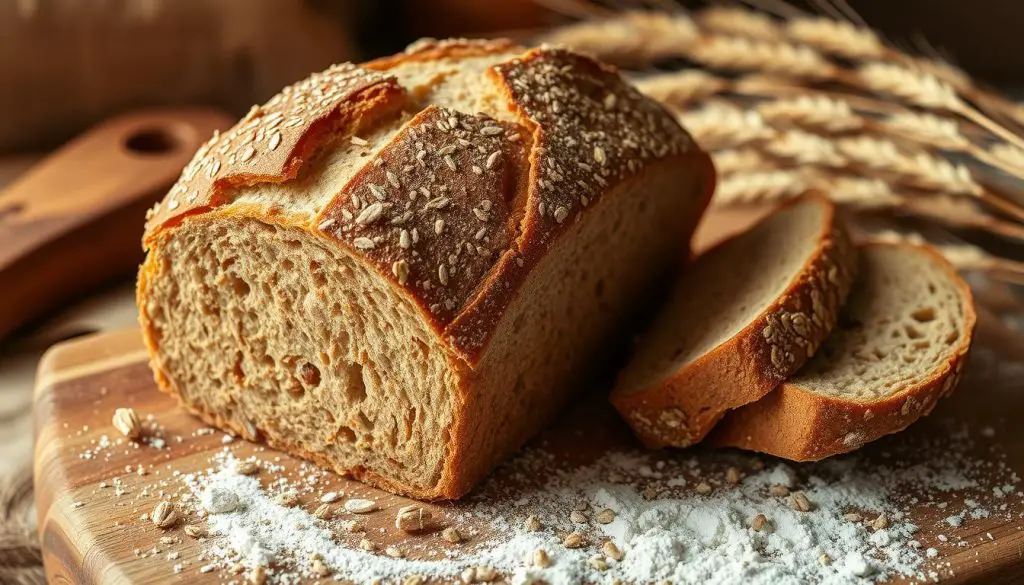
Wild Rice: Nutrient-Dense Alternative
Wild rice distinguishes itself from other grains with its elevated protein, fiber, and lower glycemic index. This makes it an ideal choice for those aiming to incorporate low glycemic carbs into their diet. Its distinctive earthy flavor and chewy texture further enhance its appeal, offering a refreshing alternative to traditional grains.
Comparing Wild Rice to Other Grains
Contrary to its name, wild rice is not a true rice but rather the seed of an aquatic grass native to North America. This unique origin contributes to its superior nutritional profile, featuring higher concentrations of folate, magnesium, and zinc. These nutrients are crucial for heart and digestive health, positioning wild rice as a vital component of a well-rounded, carbohydrate-rich diet.
Preparation Methods
Optimal enjoyment of wild rice necessitates proper preparation. Unlike white or brown rice, it demands a longer cooking period to achieve the perfect texture. A 45-60 minute simmer in broth or water yields a tender, fluffy result. To elevate the flavor, consider adding herbs, spices, or aromatic vegetables to the cooking liquid. Wild rice’s unique nutty taste and firm texture make it a versatile ingredient, suitable for a wide range of dishes, from pilafs and stews to salads and casseroles.
FAQ
What are the top carbohydrate-rich foods for energy and health?
The pinnacle of carbohydrate-rich foods for energy and health includes quinoa, sweet potatoes, and brown rice. Oats, bananas, and whole grain pasta also hold a prominent place. Legumes, ancient grains like amaranth and teff, apples, chickpeas, butternut squash, and whole grain bread are equally beneficial.
What is the difference between simple and complex carbohydrates?
Simple carbohydrates, or “simple sugars,” are swiftly digested and absorbed, offering an immediate energy surge. Examples include table sugar, honey, and fruits. Conversely, complex carbohydrates, or “starches,” are digested more slowly, providing sustained energy. Whole grains, vegetables, and legumes exemplify this category.
How much carbohydrate should I consume daily?
The daily carbohydrate intake varies, but it’s generally advised that carbs should constitute 45-65% of your total caloric intake. For a 2,000-calorie diet, this translates to 225-325 grams of carbohydrates daily.
What are the benefits of quinoa, and how can I incorporate it into my diet?
Quinoa, a complete protein grain, is also rich in fiber, vitamins, and minerals. It can substitute for rice, enhance salads, or serve as the foundation for grain bowls and casseroles.
Why are sweet potatoes considered an energy powerhouse?
Sweet potatoes are a treasure trove of complex carbohydrates, fiber, and essential vitamins and minerals like vitamin A, vitamin C, and potassium. They offer sustained energy and bolster overall health, making them ideal for athletes and the active.
How can I incorporate more brown rice into my diet?
Brown rice can be the cornerstone for stir-fries, a component in soups and stews, or a staple in grain bowls. It’s also suitable for making brown rice pilafs or as a side dish.
What are the different types of oats, and how can I make my oatmeal more interesting?
Oats come in three primary forms: steel-cut, old-fashioned, and quick-cooking. To enliven your oatmeal, consider adding fresh or dried fruit, nuts, nut butters, cinnamon, or even cocoa powder.
How can bananas provide a quick energy boost?
Bananas, a rich source of natural sugars and carbohydrates, offer a swift energy lift. They also contain potassium and vitamin B6, which aid in muscle function and energy metabolism.
What should I look for when choosing whole grain pasta?
When selecting whole grain pasta, prioritize products labeled as “100% whole grain” or “whole wheat” as the first ingredient. Steer clear of refined white pastas, which lack fiber and nutrients.
What are the benefits of incorporating legumes into my diet?
Legumes, such as beans, lentils, and peas, are a treasure trove of complex carbohydrates, protein, fiber, and essential nutrients. They support weight management, blood sugar regulation, and heart health.
What are some popular ancient grain varieties, and how can I cook with them?
Ancient grains like amaranth, teff, sorghum, and quinoa are gaining popularity. These grains can be cooked like rice, added to salads and bowls, or used in baking to enhance texture and nutrition.
How can apples provide a natural energy boost?
Apples, a source of natural sugars and fiber, offer a steady energy boost. They also contain antioxidants and various vitamins and minerals that support endurance and post-workout recovery.
What are the benefits of including chickpeas in my diet?
Chickpeas, a versatile source of complex carbohydrates, protein, and fiber, provide sustained energy. They can be roasted as a snack, added to salads and bowls, or used in dishes like hummus and curries.
How can I incorporate butternut squash into my meals for an energy boost?
Butternut squash, rich in vitamin A and complex carbohydrates, can be roasted and added to salads, soups, or served as a side dish. It’s an excellent choice for boosting energy and adding nutrients to your meals.
What are the benefits of whole grain bread, and how can I choose the healthiest options?
Whole grain bread is a steady source of complex carbohydrates, fiber, and essential nutrients. When selecting whole grain bread, look for products with “100% whole grain” or “whole wheat” as the first ingredient. Avoid those with added sugars or refined flours.
How does wild rice compare to other grains, and how can I prepare it?
Wild rice, a nutrient-dense grain, surpasses other rice varieties in protein, fiber, and antioxidants. It can be cooked like regular rice, added to salads and bowls, or used in casseroles and pilafs.


